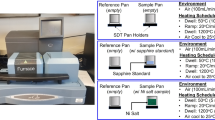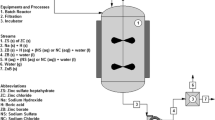Abstract
Products obtained via precipitation from the reactions of uranium compounds with hydrazine were characterized by thermal analysis and other methods. Precipitates of uranium oxides were isolated from the reactions with hydrazine at 60 and 100°C. Upon heating in an inert atmosphere, the samples underwent dehydration, accompanied by decomposition of the hydrazine. Hydrazine and its decomposition products, ammonia and hydrogen, partially reduced the uranium(VI) to uranium(IV) oxide. The products obtained by precipitation at 60°C were stable in air. In contrast, the products obtained on reduction at 100°C exhibited pronounced sensitivity toward oxidation by air.
Zusammenfassung
Aus Uranverbindungen mit Hydrazin gefällte Produkte werden mittels Thermoanalyse und anderen Methoden beschrieben.
Niederschläge von Uranoxiden wurden aus der Reaktion mit hydrazin bei 60 und 100°C isoliert. Bei Erhitzen in inerter Atmosphäre werden die Proben unter gleichzeitiger Zersetzung des hydrazins dehydratiert. Hydrazin und seine Zersetzungsprodukte Ammoniak un Wasserstoff reduzieren Uran(VI)-oxide teilweise zu Uran(IV)-oxiden. Die beim Fällen bei 60°C erhaltenen Produkte sind an Luft stabil. Im Gegensatz dazu besitzen die bei der Reduktion bei 100°C erhaltenen Produkte gegenüber der Oxydation an Luft eine gesteigerte Empfindlichkeit.
Similar content being viewed by others
References
R. C. Merritt, The Extractive Metallurgy of Uranium, CSMRI, Colorado, US ABC, 1971.
G. Baric, Ph. D. Thesis, University of Ljubljana, Faculty for Natural Science and Technology, 1985.
C. J. Rodden, Ed. Analytical Chemistry of the Manhatan Project, McGraw Hill Co., New York, 1950.
Chemical and Physical Analytical Methods for Nuclear Materials, Nuclear National Commision, Beograd, 1967.
A. J. Vogel, A Text Book of Quantitative Inorganic Analysis 4th Ed., Longmans, London, 1978.
W. R. McBride, R. A. Henry, S. Skolnim, Anal. Chem., 23 (1951) 890.
L. F. Audrieth, B. Ackerson Ogg, The Chemistry of Hydrazine, J. Wiley & Sons. Inc., New York, 1951.
B. V. Gromov, Vvedenije v Himiceskuju Tehnologiju Urana, Atomizdat, Moskva, 1978.
G. H. Price, J. Inorg. Nucl. Chem., 33 (1971) 4085.
F. A. Cotton and G. Wilkinson, Advanced Inorganic Chemistry 5th Ed., J. Wiley & Sons. Inc., New York, 1988, pp. 1003–1005.
Ullmanns Encyklopadie der technischen Chemie, 17. Band, Urban & Schwarzenberg, München, 1966, pp. 782–783.
Author information
Authors and Affiliations
Rights and permissions
About this article
Cite this article
Maček, J., Baric, G., Novosel, B. et al. Thermal behavior of the products isolated in uranium compound-hydrazine systems. Journal of Thermal Analysis 36, 695–705 (1990). https://doi.org/10.1007/BF01914521
Received:
Issue Date:
DOI: https://doi.org/10.1007/BF01914521




